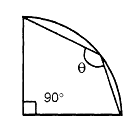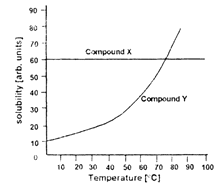 Multiple Choice Questions
Multiple Choice QuestionsWhat is the angle (θ) in the quadrant of a circle shown below?

135°
90°
120°
May have only between 90° and 120°
In () ABC, angle A is larger than angle C and smaller than angle B by the same amount. If angle B is 67°, angle C is.
67°
53°
60°
57°
See the following mathematical manipulations.
(i) Let x = 5
(ii) Then x2 – 25 = x – 5
(iii)(x – 5) (x + 5) = x – 5
(iv) x + 5 = 1 [Cancelling (x – 5) from both sides]
(v) 10 = 1 [Putting x = 5]
Which of the above is the wrong step?
(i) to (ii)
(ii) to (iii)
(iii) to (iv)
(iv) to (v)
Inner plates of the solar system are rocky, whereas outer planets are gaseous. One of the reasons for this is that
Solar heat drove away the gases to the outer region of the solar system.
Gravitational pull of the sun pulled all rocky material to the inner solar system.
Outer planets are larger than the inner planets.
Comets delivered the gaseous materials to the outer planets
The number of craters observed due to meteoritic impacts during the early stages of formation, is less on the earth than that on the Moon because,
Formation of craters on the Earth was difficult due to the presence of hard rocks.
Impacting bodies on the Earth were smaller in size.
Craters on the earth are now covered by ocean water.
Earlier craters are not preserved due to continuous modification of Earth’ssurface by geological processes.
During a total solar eclipse occurring at noon, it becomes dark enough for a few minutes for stars to become visible. The stars that are seen are those which will be seen from the same location.
On the following night only.
On the night one month later.
On the night three months later.
On the night six months later.
C.
On the night three months later.
The stars that are seen are those which will seen from the same location on the night three months later.
The variation of solubilities of two compounds X and Y in water with temperature is depicted below. Which of the following statements is true?

Solubility of Y is less than that of X.
Solubility of X varies with temperature.
Solubilites of X and Y are the same at 75°C.
Solubilities of X and Y are independent of temperature.
Living beings get energy from food through the process of aerobic respiration. One of the reactants is
Carbon dioxide
Water vapour
Oxygen
Phosphorus
Restriction endonuclease cleaves DNA molecules at specific ‘recognition sites’. One such enzyme has four recognition sites on a circular DNA molecule. After complete digestion, how many fragments would be produced upon reaction with this enzyme?
4
5
3
6
Which of the following statements about the concentration of CO2 in the Earth’s atmosphere is true?
It was the highest in the very early atmosphere of the Earth.
It has steadily decreased since the formation of the Earth’s atmosphere.
It has steadily increased since the formation of the Earth’s atmosphere.
Its levels today are the highest in the Earth’s history.
